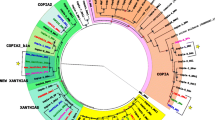Abstract
Several copies of the Penelope transposable element, previously described in Drosophila virilis, have been studied in different D. virilis strains and D. melanogaster strains transformed with P-based constructs bearing a full-size Penelope copy. Most Penelope copies in both species have large terminal inverted repeats (TIRs) and deletions of various sizes at the 5′ ends of their ORFs. Junctions between TIRs and ORFs usually have microhomologies of various lengths, which allowed a hypothesis explaining the emergence of these complex structures at the molecular level to be put forward. Most Penelope copies have a 34 bp long direct repeat at the ORF ends. Full-size and truncated Penelope copies are usually surrounded by target site duplications of various lengths.
Similar content being viewed by others
References
Arkhipova I.R., Pyatkov K.I., Meselson M., Evgen’ev M.B. 2003. Retroelements containing introns in diverse invertebrate taxa. Nature Genet. 33, 123–124.
Evgen’ev M.B., Arkhipova I.R. 2005. Penelope-like elements, a new class of retroelements: Distribution, function and possible evolutionary significance. Cytogenet. Genome Res. 110, 510–521.
Arkhipova I. 2006. Distribution and phylogeny of Penelope-like elements in eukaryotes. Syst. Biol. 6, 875–885.
Petrov D., Schutzman J., Hartl D., Lozovskaya E. 1995. Diverse transposable elements are mobilized in hybrid dysgenesis in Drosophila virilis. Proc. Natl. Acad. Sci. USA. 92, 8050–8054.
Evgen’ev M., Zelentsova H., Shostak N., Kozitsina M., Barsky V., Lankenau D., Corces V. 1997. Penelope, a new family of transposable elements and its possible role in hybrid dysgenesis in Drosophila virilis. Proc. Natl. Acad. Sci. USA. 94, 196–201.
Vieira J., Vieira C.P., Hartl D.L., Lozovskaya E.R. 1998. Factors contributing to the hybrid dysgenesis syndrome in Drosophila virilis. Genet. Res. 71, 109–117.
Dalle Nogare D.E., Clark M.S., Elgar G., Frame I.G., Poulter R.T. 2002. Xena, a full-length basal retroelement from tetraodontid fish. Mol. Biol. Evol. 19, 247–255.
Pyatkov K.I., Arkhipova I.R., Malkova N.V., Finnegan D.J., Evgen’ev M.B. 2004. Reverse transcriptase and endonuclease activities encoded by Penelope-like retroelements. Proc. Natl. Acad. Sci. USA. 101, 14719–14724.
Lyozin G.T., Makarova K.S., Velikodvorskaja V.V., Zelentsova H.S., Khechumian R.R., Kidwell M.G., Koonin E.V., Evgen’ev M.B. 2001. The structure and evolution of Penelope in the virilis species group of Drosophila: An ancient lineage of retroelements. J. Mol. Evol. 52, 445–456.
Pyatkov K.I., Shostak N.G., Zelentsova E.S., Lyozin G.T., Melekhin M.I., Finnegan D.J., Kidwell M.G., Evgen’ev M.B. 2002. Penelope retroelements from Drosophila virilis are active after transformation Drosophila melanogaster. Proc. Natl. Acad. Sci. USA. 99, 16150–16155.
Spicer G.S. 1992. Reevaluation of the phylogeny of the Drosophila virilis species group (Diptera, Drosophilidae). Ann. Entomol. Soc. Am. 85, 11–25.
Spradling A.C. 1986. P-element-mediated transformation. In: Drosophila: A Practical Approach. Ed. Roberts D.B. Oxford: CIRL Press, pp. 175–197.
Wang W., Swevers L., Iatrou K. 2000. Mariner (Mos1) transposase and genomic integration of foreign gene sequences in Bombyx mori cells. Insect. Mol. Biol. 2, 145–155.
Sambrook J., Fritsch E.F., Maniatis T. 1989. Molecular Cloning. A Laboratory Manual, 2nd ed. Cold Spring Harbor, NY: Cold Spring Harbor Lab. Press.
Eggert H., Bergemann K., Sauweber H. 1998. Molecular screening for P-element insertions in a large genomic region of Drosophila melanogaster using polymerase chain reaction mediated by the vectorette. Genetics. 149, 1427–1434.
Schostak N., Pyatkov K., Zelentsova E., Arkhipova I., Shagin D., Shagina I., Mudrik E., Blintsov A., Clark I., Finnegan D., Evgen’ev M. 2008. Molecular dissection of Penelope transposable element regulatory machinery. Nucleic Acids Res. 36, 2522–2529.
Arkhipova I.R., Penelope retrotransposons from D. willistoni. 2007. Repbase Reports. 7, 661–662.
Babushok D., Ostertag E., Courtney C.E., Choi J.M., Kazazian H. 2006. L1 integration in a transgenic mouse model. Genome Res. 16, 240–250.
Gilbert N., Lutz S., Morrish T., Moran J. 2005. Multiple fates of L1 retrotransposition intermediates in cultured human cells. Mol. Cell. Biol. 25, 7780–7795.
Kazazian H. 2004. Mobile elements: Drivers of genome evolution. Science. 303, 1626–1632.
Ostertag E., Kazazian H. 2001. Twin priming: A proposed mechanism for the creation of inversions in L1 retrotransposition. Genome Res. 11, 2059–2065.
Gilbert N., Lutz S., Moran J. 2002. Genomic deletions created upon LINE-1 retrotransposition. Cell. 110, 315–325.
Author information
Authors and Affiliations
Corresponding author
Additional information
Original Russian Text © V.K. Ravin, M.B. Sukchev, E.S. Zelentsova, N.G. Shostak, M.B. Evgen’ev, 2009, published in Molekulyarnaya Biologiya, 2009, Vol. 43, No. 2, pp. 357–367.
These two authors made equal contributions to this work
Rights and permissions
About this article
Cite this article
Ravin, V.K., Sukchev, M.B., Zelentsova, E.S. et al. Structural and functional analysis of a new retrotransposon class in Drosophila species. Mol Biol 43, 329–338 (2009). https://doi.org/10.1134/S0026893309020150
Received:
Accepted:
Published:
Issue Date:
DOI: https://doi.org/10.1134/S0026893309020150




